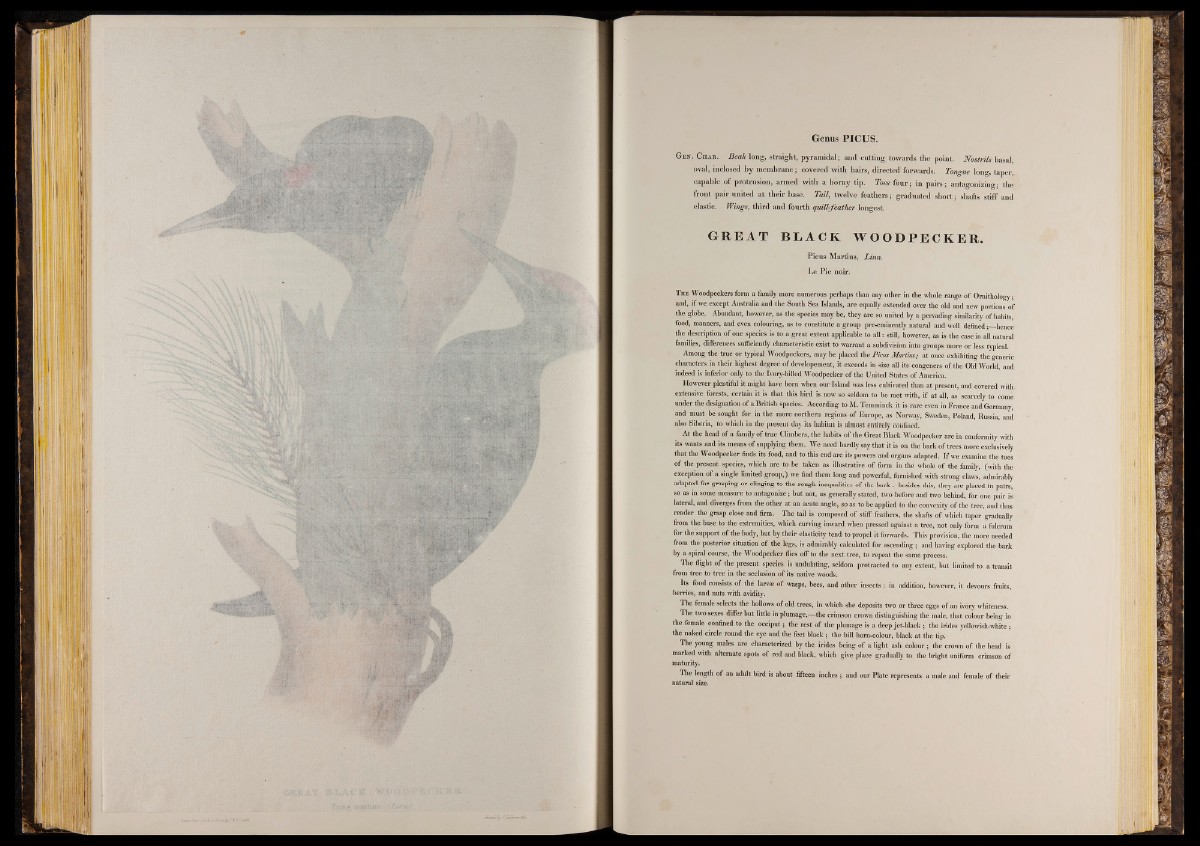
Genus FICUS.
Gen. Chau. Beak long, straight, pyramidal; and cutting towards the point. Nostrils basal,
oval, inclosed b y membrane; covered with hairs, directed forwards. Tongue long, taper,
capable o f protrusion, armed with a horny tip. Toes fo u r; in p a irs ; antagonizing; the
front pair united at their base. Tail, twelve feathers; graduated sh o rt; shafts stiff and
elastic. Wings, third and fourth quilkfeather longest.
G R E A T B L A C K WO O D P E C K E R .
Picus Martius, Linn.
Le Pic noir.
The Woodpeckers form a family more numerous perhaps than any other in the whole range of Ornithology ;
and, if we except Australia and the South Sea Islands, are equally extended over the old and new portions of
the globe. Abundant, however, as the species may be, they are so united by a pervading similarity of habits,
food, manners, and even colouring, as to constitute a group pre-eminently natural and well defined ¡—hence
the description of one species is to a great extent applicable to all; still, however, as is the case in all natural
families, differences sufficiently characteristic exist to warrant a subdivision into groups more or less typical.
Among the true or typical Woodpeckers, may be placed the Pirns Martius; at once exhibiting the generic
characters in their highest degree o f developement, it exceeds in size all its congeners o f the Old World, and
indeed is inferior only to the Ivory-billed Woodpecker of the United States of America.
However plentiful it might have been when our Island was less cultivated than at present, and covered with
extensive forests, certain it is that this bird is now so seldom to be met with, if at all, as scarcely to come
under the designation o f a British species. According to M. Temminck it is rare even in France and Germany,
and must be sought for in the more northern regions o f Europe, as Norway, Sweden, Poland, Russia, and
also' Siberia, to which in the present day its habitat is almost entirely confined.
At the head of a family of true Climbers, the habits of the Great Black Woodpecker are in conformity with
its wants and its means o f supplying them. We need hardly say that it is on the bark o f trees more exclusively
that the Woodpecker finds its food, and to this end are its powers and organs adapted. If we examine the toes
of the present species, which are to be taken as illustrative of form in the whole of the family, (with the
exception of a single limited group,) we find them long and powerful, furnished with strong claws, admirably
adapted for grasping or clinging to the rough inequalities of the bark ; besides this, they are placed in pairs,
so as in some measure to antagonize; but not, as generally stated, two before and two behind, for one pair is
lateral, and diverges from the other at an acute angle, so as to be applied to the convexity of the tree, and thus
render the grasp close and firm. The tail is composed o f stiff feathers, the shafts of which taper gradually
from the base to the extremities, which curving inward when pressed against a tree, not only form a fulcrum
for the support of the body, but by their elasticity tend to propel it forwards. This provision, the more needed
from the posterior situation of the legs, is admirably calculated for ascending; and having explored the bark
by a spiral course, the Woodpecker flies off to the next tree, to repeat the same process.
The flight of the present species is undulating, seldom protracted to any extent, but limited to a transit
from tree to tree in the seclusion of its native woods.
Its food consists of the larvae of wasps, bees, and other insects : in addition, however, it devours fruits,
berries, and nuts with avidity.
The female selects the hollows of old trees, in which she deposits two or three eggs of an ivory whiteness.
The two sexes differ but little in plumage,— the crimson crown distinguishing the male, that colour being in
the female confined to the occiput; the rest o f the plumage is a deep jet-black; the irides yellowish-white ;
the naked circle round the eye and the feet black ; the bill horn-colour, black at the tip.
The young males are characterized by the irides being o f a light ash colour ; the crown of the head is
marked with alternate spots of red and black, which give place gradually to the bright uniform crimson of
maturity.
The length o f an adult bird is about fifteen inches ; and our Plate represents a male and female of their
natural size.